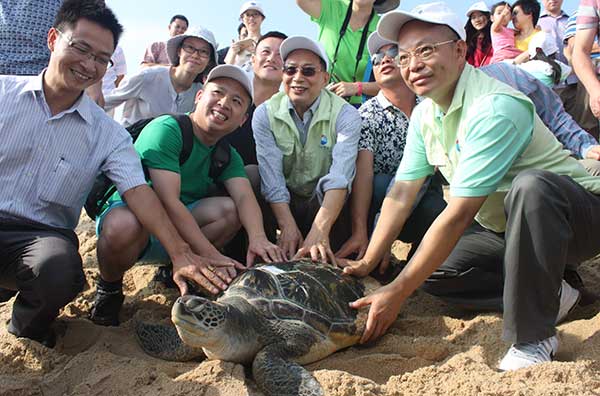Hope blossoms for endangered turtles
 0 Comment(s)
0 Comment(s) Print
Print E-mail China Daily, September 27, 2016
E-mail China Daily, September 27, 2016
After cautiously making sure that no peril is in sight, a sea turtle crawls onto a beach in the darkness. It digs a hole in the sand and begins to lay eggs inside. After laying more than 100, the turtle covers the nest with sand, scrapes it smooth and returns to the ocean.
 |
|
Animal lovers take pictures with a sea turtle in October before it is set free at the National Huizhou Sea Turtle Reserve. Cai Ruizhi / For China Daily |
This scenario happens several times a year at National Huizhou Sea Turtle Reserve. About 80 kilometers east of Shenzhen, the reserve's 1-kilometer-long beach contrasts with the aquamarine of the South China Sea. Beyond the sand, in the hills, researchers fight to keep the turtles from extinction.
Established in 1985, the reserve has witnessed a drop in the number of laying sea turtles - from more than 100 yearly in the 1980s to single digits now.
"Only a few sea turtles have laid eggs in recent years," said Wang Shaofeng, deputy director of the reserve. "And, unfortunately, there hasn't been one yet this year."
The crisis of the sea turtle in China is a microcosm of the situation worldwide. Six out of the seven species of sea turtles (one has insufficient data) face the problem of declining numbers and are marked as "vulnerable", "endangered" or even "critically endangered" - one step away from extinction - on the red list of threatened species maintained by the International Union for the Conservation of Nature.
The reserve in Huizhou is the only known active laying ground remaining for sea turtles along the 18,000-kilometer coastline of the Chinese mainland.
Still, everyone at the reserve is giving their best to help hatch the eggs, nurture the hatchlings, save wounded turtles and raise public awareness through exhibitions about wildlife conservation.
The turtle reserve represents only a fraction of the work being done to improve the water quality and biodiversity of the sea.
Corals have been transplanted from areas that could potentially be harmed by a pipeline, even though, according to China National Offshore Oil Corp, waste has been repeatedly cleansed to meet extremely high standards before being discharged into the ocean.
Thousands of mangrove trees have been planted to replace unregulated oyster farms whose dikes have blocked the free flow of water, which would normally result in cleaner water from dilution. Unregistered fishing boats have been banned to eliminate poachers.
"We've been engaging these multiple methods to keep the environment in a relatively good state," said Wang Zhengyin, director of Huizhou city's Administration of Ocean and Fisheries. "We use the land and the ocean in an intensive yet thrifty manner."
Awareness is also passed on to youngsters visiting the reserve by their parents.
"We brought our son here to see the rare creature, and also to teach him lessons about environmental protection," said Lin Sheng, a visitor from the Huizhou urban area, holding the hand of her 7-year-old son.
Researchers maintain an optimistic attitude about seeing more turtles laying eggs.
"One factor is that it takes sea turtles 20 or even 50 years to reach puberty," the city's Wang said. "So it might take a while before we see a substantial increase.
"Plus, as sea turtles are migratory creatures, it will require joint efforts from different countries to better conserve the species. Our GPS data show that a turtle released from here travels to Japan or to the Philippines, but they will eventually come back to lay eggs here."






Go to Forum >>0 Comment(s)